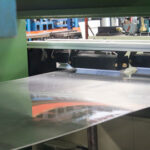Top Three Benefits of Using Less Metalworking Fluid in Your Stamping Process
 There is a time and a place for friction. Without friction, we wouldn’t be able to walk, drive a car, write on paper, hammer a nail into a wall, or warm up our hands by rubbing them together. But too much friction in a stamping or metalworking process has profound implications, from tool wear to scrapping parts. Thanks to the work of Leonardo DaVinci, who was one of the first to experiment with fluids in his study of friction and machine operations, as well as countless inventors and physicists, today, we have a solid understanding of the impacts of friction and how to control it using metalworking fluids or stamping fluids.
There is a time and a place for friction. Without friction, we wouldn’t be able to walk, drive a car, write on paper, hammer a nail into a wall, or warm up our hands by rubbing them together. But too much friction in a stamping or metalworking process has profound implications, from tool wear to scrapping parts. Thanks to the work of Leonardo DaVinci, who was one of the first to experiment with fluids in his study of friction and machine operations, as well as countless inventors and physicists, today, we have a solid understanding of the impacts of friction and how to control it using metalworking fluids or stamping fluids.
While metalworking fluids and their costs are necessary parts of the stamping process, many manufacturers overuse fluids – some without knowing it. With advances in the application, such as roller coaters, and a detailed look at how fluid is used in your stamping process, you can dramatically reduce your fluid consumption. And more importantly, you gain the benefits of reduced costs, reduced waste, and a healthier work environment.
Cost Savings
The math is simple – if you use less, it lowers your costs. But it’s not only fluid consumption that drives the overall expense. You’ll also reduce associated costs, such as maintenance, part and floor cleaning, and waste management.
A client in the automotive industry spent $115,000 annually on coolants for two process areas in their shop. Replacing the spraying system with roller systems reduced their overall costs by $82,000. Specifically, detailing the potential cost savings, the roller systems were estimated to have directly reduced fluid consumption by $29,000/yr.; reduced waste-hauling costs by $19,000; cut floor-cleaner consumption in half (saving another $1,500/yr.); and even reduced costs for rags and gloves by another $1,250, the roller systems paid for themselves in less than a year.
Waste Reduction & Environmental Impact
Taking care of stamping fluids doesn’t stop when production ends. When metalworking fluids are no longer useable, you must ensure they are captured and disposed of properly. A fluid lifecycle analysis will help you maximize fluid use, determine if any can be reclaimed, and reduce overall waste. This lowers your disposal costs and lessens your impact on the environment.
Safer Work Environment
Industrial fluids that drip down the side of a stamping press, mist in the air, or puddle on the floor do nothing to help your manufacturing process. In addition to making a mess, the excess fluids are hazardous to workers. Oils and fluids on the floor can quickly result in slip and fall incidents. Occupational exposure to metalworking fluids may cause various health effects, including hypersensitivity pneumonitis (HP), chronic bronchitis, impaired lung function, and asthma. By eliminating excess fluids, you reduce the risk to your employees and create a safer and healthier work environment.
The Impact Fluids Approach
The Impact Fluids approach helps your company reduce fluid usage by as much as 50%-90%. This significantly reduces the dollars you spend on fluids and associated costs. Our ongoing service includes quarterly or biannual Fluid Lifecycle reviews to ensure the equipment, fluids, and procedures continue to work as intended. Our goal is to help you improve your bottom line through the accurate mixing, application, filtration, and proper fluid selection while reducing your environmental impact.
Let’s start lowering costs with a Fluid Lifecycle Analysis for your organization. Contact us today!
